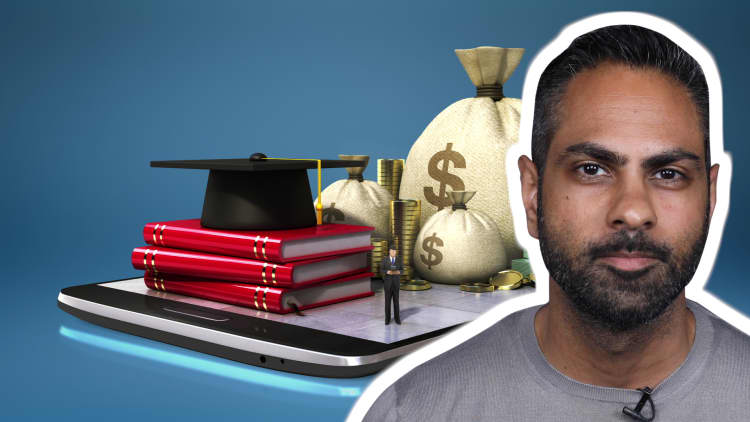If you want to keep your child from graduating with insurmountable debt, put down the glossy college brochures and break out your calculators.
More than 6 out of 10 students polled by College Ave Student Loans said they feel they have a good understanding of the different types of loans and payments available.
Yet nearly 40 percent of the 1,307 participants said they were uncertain of the difference between private and federal loans.
The company, a provider of college financing, polled the students in October 2018.

In all, student loan debt is now at a record $1.5 trillion as of the third quarter of 2018, according to the Federal Reserve.
"It's intuitive that when you get to school, you worry about making friends and handling your academics," said Joe DePaulo, CEO of College Ave Student Loans.
"I think the most important thing they can figure out is what will be your monthly payment when you graduate?" he said.
Here are three things your child should know before borrowing to get through college.
How much should you borrow?
Before applying for loans, take a step back and see how the full cost of tuition stacks up against your sources of "free money," including scholarships and grants.
If you have to borrow, go for federal loans first, as they generally have terms that are more borrower-friendly.
"The rule of thumb is that you shouldn't borrow more than what you think your first year's annual salary will be," said DePaulo.
What's the monthly payment?

The real test of whether your loans are affordable comes down to what happens after you've started the repayment process: How much is the monthly payment?
There are three major criteria driving that statement: the sum that you've borrowed, the interest rate on the loan and the duration of your repayment period, said DePaulo.
A longer repayment period might lead to smaller monthly payments, but it'll take you a longer time to get out of debt. Meanwhile, a lower interest rate means that more of your monthly payment will go toward crushing the principal owed.
Getting an idea of your payment will also help you understand how the bill fits within your monthly budget: Can you comfortably swing your student loan payment while juggling your rent, phone bill and other obligations?
Is it federal or private?
The government funds federal loans, while banks provide private loans.
This is a key distinction, because federal loans offer borrowers certain terms they may not be able to get with a private loan.
For instance, federal loans offer borrowers income-driven repayment plans in the event they have difficulty affording the repayment.
Students also don't have to start paying back the federal loan until after they graduate, leave school or reduce their enrollment status to below half-time.
These loans also offer fixed interest rates. Currently, the rate on an undergraduate federal loan is 5.05 percent.
On the other hand, private student loans may have fixed or variable rates, and they may require that you make payments while your child is in school.
Interest accrues in the meantime and is added to the principal amount owed once your child graduates.
Further, if you or your child run into problems with affording the monthly payment on a private loan, you'd have to work with your lender to figure out a solution. Unlike with a federal loan, you wouldn't have an income-driven repayment plan to fall back on.
"We forget that many of the students borrowing this money are 18 and have never borrowed before," said DePaulo. "This first loan is the longest one they will have."
More from Personal Finance
Small businesses feel shutdown pain. How to find some wiggle room
What you should know about your 2018 tax return
These are the retirement destinations with the best weather


